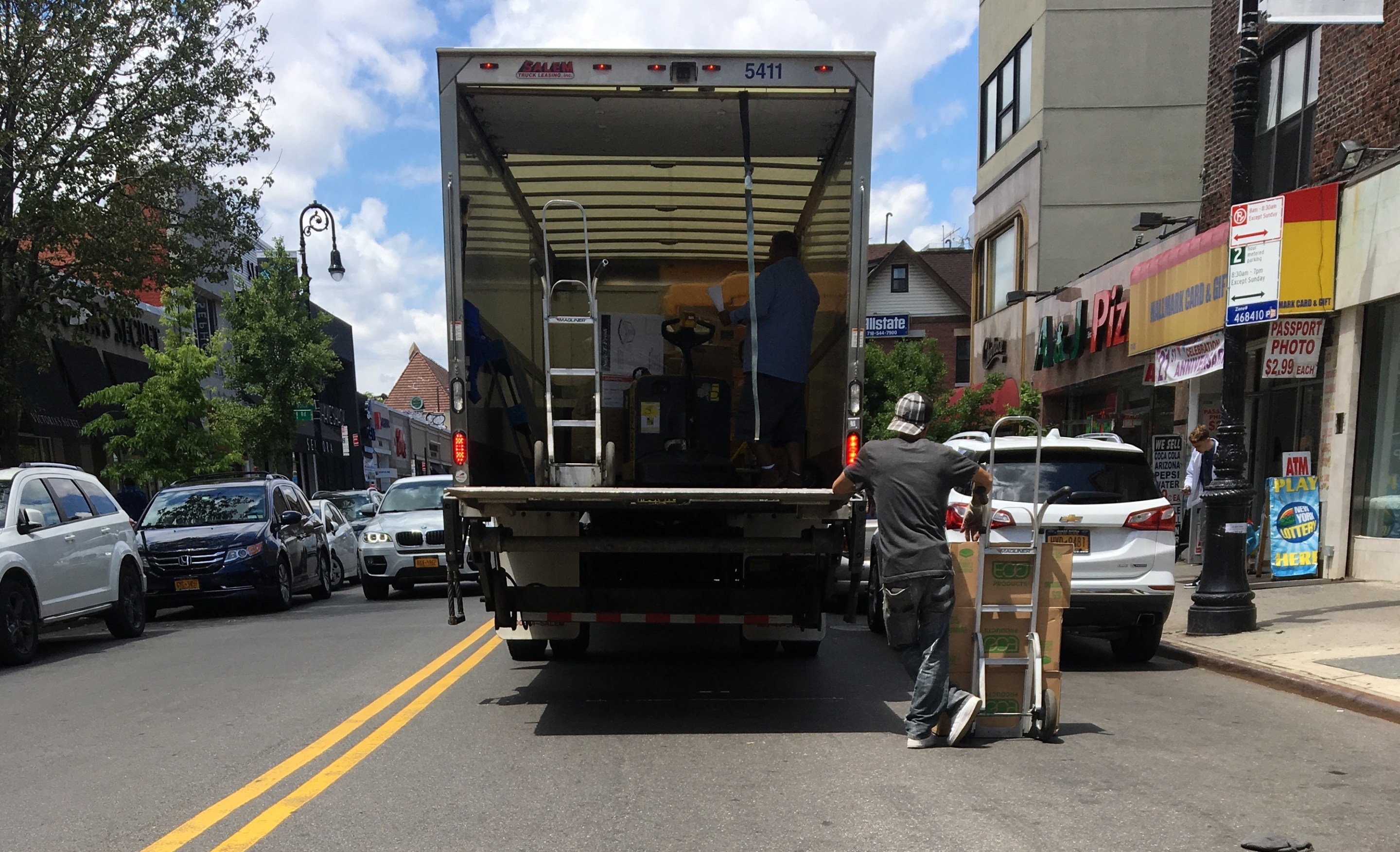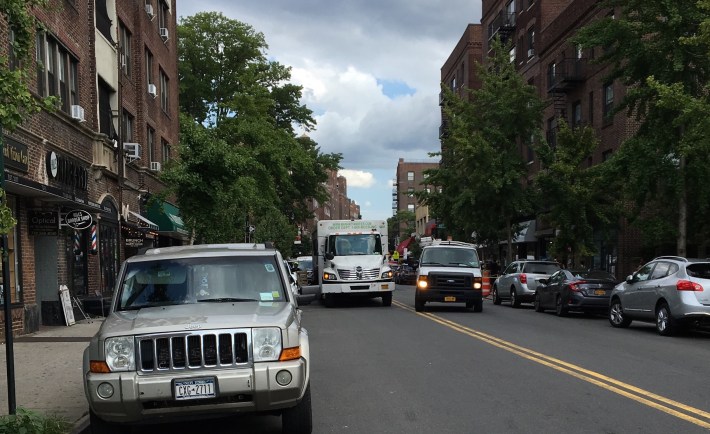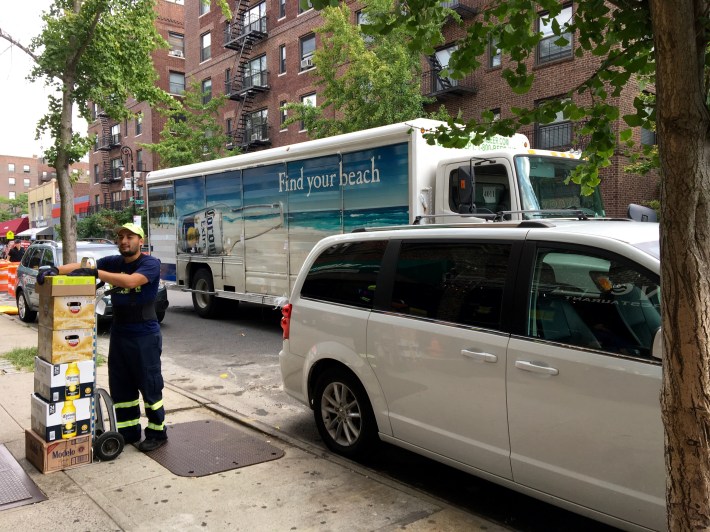City Loading Zone Plan Will Help Ease Traffic On Austin Street In Queens — But Local Pols Still Oppose It
8:00 AM EDT on August 27, 2018

Business as usual on traffic-choked Austin Street in Forest Hills. Photo: Laura A. Shepard
Politicians and supposed business leaders in Forest Hills still oppose a watered-down version of a city plan to expand loading zones along commercial Austin Street, but consumers, shopkeepers and people who actually understand how traffic works support the idea as a way of reducing the roadway's epic congestion.
The plan calls for nine new loading zones between Ascan Avenue and 69th Road, a reduction from the 12 zones in the initial proposal. DOT also tweaked the locations and reduced the hours after meeting with the Forest Hills Chamber of Commerce. Instead of starting at 7 a.m., as originally proposed, the nine loading zones will go into effect at 8:30 a.m. and end at varying times throughout the day to restore on-street parking of private vehicles. Only one new loading zone remains in effect until 4 p.m.
Even though the plan has been defanged a bit, business owners think it will ease congestion.
“It will definitely help, of course, we have a lot of deliveries,” Nobu Tobten, an employee at A&J Pizza said. “It’s a very busy area, there’s bad traffic, it’s hard to find parking, and our delivery trucks always get tickets.”
Jezebel Shaffeeullah, an employee at Shake Shack, also supports this plan. “It’ll be better because Austin Street is so crowded,” she said.
The eatery receives daily deliveries from trucks whose drivers park directly in front the restaurant — double-park if there are cars already along the curb, she said. Since the burger joint abuts the Long Island Railroad, there’s no access in the back, so all supplies are carted in through the front door.
Other restaurant businesses support the loading zone plan as well.
“It would be helpful to me as a business owner,” said Ryan Clur of Red Pipe Cafe. “We get deliveries on a daily basis. The trucks block the streets and it’s a large source of frustration. If there are places trucks can park to unload, it will improve the flow of traffic.”
Clur said he would prefer to see the street converted to a car-free promenade, like Times Square, where a large part of the street is dedicated to seating.
“People drive fast and recklessly here,” Clur added. “I’d like to see some form of traffic calming. Better traffic calming makes the street safer and is beneficial to businesses.”
Some business owners — predictably those who drive their own cars to the neighborhood and enjoy low-price, curbside parking all day — have objected to the plan.
Nick Marshal, who works at 718 Hookah Lounge, drives to the smoke shop from Glendale and parks all day on Austin Street for about $6 — one of 41 drivers who DOT observed just sitting there for at least six hours along Austin Street in a single day of observation.
“Parking is already bad and this plan will make it worse,” Marshal said. "Trucks will still double park. They don’t care because they’re not paying the tickets, the company does.”
Comments like that led Assemblyman Andrew Hevesi and Council Member Karen Koslowitz to oppose the plan, but DOT said it surveyed businesses in October 2017 and found that 70 percent of respondents agreed or strongly agreed to the statement, “Trucks disrupting traffic is a problem.”
The extent of the problem depends on the time of day. Currently, many trucks make deliveries before 10 a.m., when the congestion on Austin Street begins as businesses open. After 10 a.m., trucks compete with cars for the curbside, and in any given hour, DOT observed dozens of double-parked trucks on a strip where even one double-parked truck is a traffic disaster.

"Any double parking incident means significant congestion on a road with one lane in either direction," DOT said in its report.
To complement the additional loading zones, DOT plans to raise the cost of metered parking — and extend its hours — along much of the strip as well.
The reason? "Occupancy at the curb is high," the DOT said. And "many vehicles are staying parked far past the posted two-hour limits."
Several small businesses told Streetsblog that their deliveries are fast, often under 10 or 20 minutes, so they oppose loading zones that clear up curb space for hours. When pressed, however, businesses admitted they cannot predict exactly when their deliveries will arrive, which is why DOT says it needs to set aside several loading zones that remain clear until 11 a.m., several that will remain available until 1 p.m., and one, between 70th Avenue and 70th Road, that will be available for trucks until 4 p.m.

A driver for Manhattan Beer Distributor, who asked to remain anonymous, agreed that loading zones would make his job easier. He said the company encourages drivers to park legally, but it’s difficult.
“We double park all the time and we’re in everyone’s way,” he said. “The cops ticket us every chance they get.”
Tickets are not much a disincentive. The driver knows that his company will pay the fine — and the company knows that the fine will be pennies on the dollar, if not zero, thanks to the city’s controversial Stipulated Fine Program, which the Department of Finance is trying to reform, but is under fire from the large trucking companies that currently benefit from the fine reductions.
Double parking even for 30 seconds can have fatal consequences, since it forces drivers and cyclists to cross into oncoming traffic and impairs visibility for pedestrians. Sushi Time deliveryman Sergio Perez was the victim of a hit and run on Austin Street last year. He hates double-parkers, but he also hates the drivers who speed.
“It’s not good when trucks double park,” he said. “Sometimes drivers drive crazy or go faster.”
Cycling is extremely popular in the area, judging from the fact that bike racks along Austin Street, Continental Avenue, and other side streets are consistently full. But that didn't change Koslowitz's mind about the plan. To her, anything that inconveniences drivers — even though dozens of parking spaces are occupied by people who don't move their cars all day — is bad.
“While I can appreciate DOT’s concern with traffic flow on Austin Street, the remedy cannot be at the expense of our local stores,” Koslowitz said. “We need only to witness the turnover in storefronts on Austin Street to realize that even a small dent in commercial activity could be fatal to many businesses.”
Commercial turnover is a problem on Austin Street as it is on every business strip in the city. But parking has little to do with what ails Austin, which currently has 638 metered spaces available in the immediate vicinity, plus 932 off-street spaces, according to DOT. Meanwhile, the average weekday ridership at the 71st-Continental Avenue subway station is nearly 28,000 people per day, while another 2,000 ride the Long Island Railroad. People who are shopping on Austin Street are doing it mostly on foot.
Most people who know the area don’t bother driving, they say. Robert Vintimilla, the manager at Mr. Vino’s stopped driving his car from Woodhaven because it was so impractical to search for spaces, walk long distances, or constantly feed meters. He typically take the bus to Jamaica and transfers to the subway.
One cold night, he decided to take the Q23 bus to Loubet Street, a 10-15 minute walk. The bus took 45 minutes because Target delivery trucks were double parked on Austin Street.

The one existing loading zone on Austin Street, outside of S.S. Natural Supermarket at Ascan Avenue, is in effect from 7 a.m. to 7 p.m., except Sundays. It works well, according to the owner, Min Kim, who supports the plan to add more.
Even a driver from Duane Reade agreed. The company dispatches 42 foot trucks from its distribution facility in Linden, New Jersey to supply the Forest Hills location, and two or three others. The other day, driver Everton Thompson struggled to turn the long truck onto Austin Street around another double parked truck.
He said that loading zones help him work much faster. He said his truck routinely receives tickets and that passerby often curse at him when he double parks, which also impedes buses.
Read More:
Stay in touch
Sign up for our free newsletter
More from Streetsblog New York City
Stockholm Leader’s Message to NYC: ‘Congestion Pricing Just Works’
"In Stockholm, people really thought that congestion pricing would be the end of the world, the city will come to a standstill, no one would be able to get to work anymore and all the theaters and shops would just go bankrupt. None of that happened."
Friday’s Headlines: Trump Trial Trumps Safety Edition
Is anyone going to bother to fix the dangerous mess on the streets and plazas around the Trump trial? Plus more news.
Adams Offers Bare Minimum to Seize Congestion Pricing’s ‘Space Dividend’ Opportunity
The mayor's list of projects supposedly meant to harness congestion pricing's expected reduction in traffic is mostly old news, according to critics.
OPINION: Congestion Pricing Will Help My Family Get Around As We Navigate Cancer Treatment
My partner was recently diagnosed with cancer. Congestion pricing will make getting her to treatment faster and easier.




